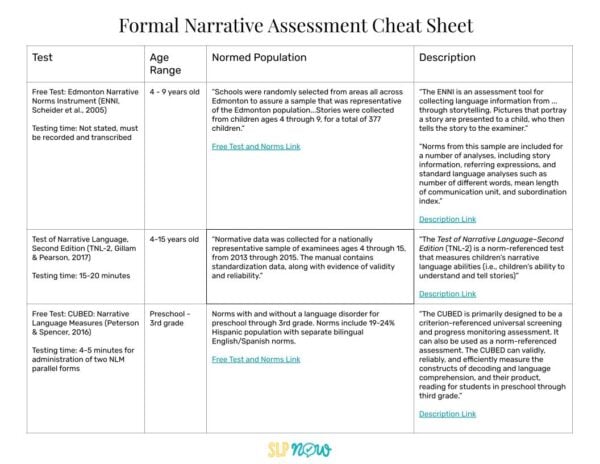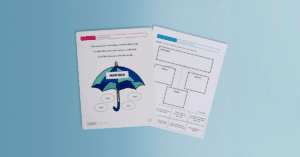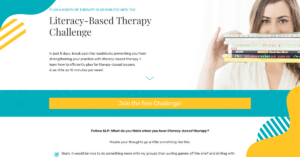Listen on Apple Podcasts Listen on Spotify
This Week’s Episode: Formal Assessment Options
I am so excited to introduce Monica Lind! She is the newest addition to the SLP Now team! She is a lead SLP in Southern California, and she is just as nerdy about evidence as I am. She has a broad range of experience as an elementary school SLP and loves literacy-based therapy.
For this month’s podcast series we’re focusing on all things narratives!
Narratives are so functional and so important when it comes to success in the classroom. Not only are they closely connected with academic achievement but they and allow students to connect socially.
We discuss how narratives are a great way to naturally measure where a student’s skills are at while also encompassing multiple different goals. We will break down 3 of our favorite formal assessment options and how to choose which assessment to use.
Grab your favorite beverage and let’s dive into discussing formal narrative assessments! 🤓
Formal Assessment Options:
– Test of Narrative Language (TNL, Gillam & Pearson, 2004)
– Edmonton Narrative Norms Instrument (ENNI, Scheider et al., 2005)
– CUBED: Narrative Language Measures (Peterson & Spencer, 2016)
Cheat Sheet

Links Mentioned
– CUBED Free Webinars
– CUBED Free Tests and Norms
– ENNI Free Tests and Norms
Subscribe & Review in iTunes
Are you subscribed to the podcast? If you’re not, subscribe today to get the latest episodes sent directly to you! Click here to make your listening experience auto-magic and as easy as possible.
Bonus points if you leave us a review over on iTunes → Those reviews help other SLPs find the podcast, and I love reading your feedback! Just click here to review, select “Ratings and Reviews,” “Write a Review,” and let me know what your favorite part of the podcast is.
Thanks so much!
Transcript
Speaker 1: Hello there. Welcome to the SLP Now podcast, where we share practical therapy, tips, and ideas for busy speech language pathologists. Grab your favorite beverage and sit back as we dive into this week's episode. Hello.
Marisha: Hello there. Welcome to the SLP Now podcast. I am super excited today because we have Monica Lynn joining us. She's the newest addition to the SLP Now team. We'll hopefully be recording many more podcasts together, but just a little bit of background on Monica since you may or may not have met her yet. She is a lead SLP for a school district in Southern California, and she is just as nerdy and all about the research as I am. She has a broad range of experience as an elementary school SLP. She's focused a lot on literacy based therapy, which we talk a lot about here, speech sound disorders, and then also functional social and language therapy, and so she's been a blast to work with.
Marisha: I hope that you enjoy getting to meet her too. Our goal for today is to dive into all things narratives. We'll start out just with quick introduction of why we're even talking about narratives this month. Monica, do you want to jump in first and share a little bit of your experience?
Monica: Yeah. Sure. I think that I really just love narratives because they're so closely connected with academic achievement. It's so functional. It's just like... When you're at a meeting and you're talking about goals and the teacher's like, "No. That's perfect. That's exactly what we work on." I feel like that's always what I'm going for, so definitely for that. I also just love the complexity of it because it's just such a good functional, natural measure of where their language skills are at. I feel like it also is a great way to add strengths in a report when you want to do that. Sometimes when you have all those formal standardized scores, it's hard. It can be tough for some of those parents to read that. But then if you do narratives, you can really highlight where their skills are at.
Marisha: Yeah. You can always find something that they're doing well with when it comes to narratives and communication and all of that. Yeah, I totally agree. I think it's cool to... Just piggybacking off of what you said, it is incredibly educationally relevant just across the curriculum, whether that's in the classroom, retelling a story that they read or on the playground, telling their friends what they did over the weekend. If they can't structure a narrative to tell that funny story or talk about what they did with their friends over the weekend, then they're really going to struggle with those social connections. Or if there's an incident on the playground and they can't tell their side of the story, that can be really frustrating for the student as well. Empowering to build those skills that they can use educationally as well as socially is incredibly rewarding. I love targeting narratives because I think we've established that it's a very meaningful context, but it also integrates a lot of different skills because we're producing sentences, which requires grammatically correct constructions and the use of vocabulary. There's also social language aspects.
Marisha: It's a really nice way to encompass a lot of different goals and we can do some really discreet practice on the different sub skills that the students need support with and then build that into similarly cool final products. Hopefully, you're on board with us too.
Monica: Yeah. You can't see because it's a podcast. I'm just sitting here nodding my head. It is. As school SLPs, we're always thinking about where can we get that big bang for your buck in narratives and putting that in part of your assessment. inaudible.
Marisha: Absolutely. Today, we are focusing a lot on assessment because we talked about why we want to target narratives in the first place, but how do we get started with them? What data do we want to collect? The first thing that we'll be diving into are some formal assessment options. I have used the Test of Narrative Language quite a bit, the TNL. The TNL is a test developed by Gillam and Pearson. It's in the second edition now. When I first started using it, it was in the first. This is a formal assessment. It's a norm-referenced test and it measures children's narrative language abilities. In other words, their ability to understand and tell stories. There's a series of stories with a series of different tasks. There are some retell involved, there's an opportunity for story generation, there's also some comprehension activities. I really liked this too. I will piggyback the assessment.
Marisha: I'll administer it as indicated by the manual and then get the standard score, but then I'll also record one or all of the retells and generations and all of that and I'll do some additional analysis on that, which we'll talk about when we get to the informal assessment option. A lot of what we'll talk about is informal assessment. This is a nice way to get some of those numbers, although we don't want to base all of our decisions off of a number. But that's a discussion for another day. Then another tool that I've learned about is the Edmonton Narrative Norms Instrument. This is the ENNI, E-N-N-I. It's another assessment tool and it's normed on children four to nine years old. It also uses a similar structure where they have illustrated pictures and then there's protocol to follow in terms of how we administer that. It's similar to the TNL, but it only has local norms.
Marisha: It was collected from 377 children in Edmonton, Canada. If you don't have access to the TNL, that can be a good option. Then if the normative sample doesn't match your students, it can also be a great additional tool to collect additional data. It's all free to access. They have some really cool demos and all of that on their site.
Monica: Then the next one is the Cubed. That's by Peterson and Spencer. They, I think relatively recently, have the norms for that. The cube has two parts. One is the narrative language measures and the other one is the dynamic decoding measures, and so I do the narrative language measures one. That one is preschool to third grade. You can use it as a progress monitoring one, so it has fall and winter. It has listening retell, comprehension, and personal generation. I really like it because it has norms. You can do it either for the entire normative sample or you can do it just for bilingual English-Spanish only. The school that I work at has a really large English-Spanish bilingual population, so I can make sure that I'm comparing the norms to that. It can also be used to do a dynamic assessment if you want to do that.
Monica: You can do the first benchmark one and then you can do a teaching part, and then you can do the second one because... We'll talk about one in a little bit that's called The Diamond. That one's grades one through six. If you have preschool through third grade, that works really well for that. They also have free recorded webinars on their website, not for CES, but it's just cool to be able to have those webinars so you can see it and you can see how the assessment is done. Sometimes it's overwhelming to think about learning a new test to give, but it's got the videos there so you can see how that's done.
Marisha: That's awesome. We'll link to more details for all of these assessments in the show notes, so you can take a closer look. We'll make sure to make it super easy for you to find those free recorded webinars. I think it'd be interesting to chat a little bit about how do we decide which formula assessment we want to use. We're going to dive into the informal assessments in the next segment here, but do you have any tips on how you decide Monica?
Monica: I think about the language that's used in the testing since I usually have younger kids. If the language used in the testing, they're not even going to be able to understand that, they won't understand what the story means, they won't understand what the directions are necessarily, I'm thinking about, is that actually going to test what I want, first of all. Then if it's appropriate for them... The Cubed has a lot more they're skateboarding or they're going to the park. It's a lot more relevant, so I like it. I Usually have younger students, so that's first how I'll do it. Then second, I'll look at the normed population. Is that relevant to my population? Do I feel like it's representative of them, so it'll be a really accurate score for me to compare to them? I think that's where I start off.
Marisha: Yeah, absolutely. Especially with your population because it sounds like you use the Cubed most often because that normative sample, the other assessments, you wouldn't be able to use the scores because they don't match up. That's one thing that we mentioned about the ENNE. If we want to use the norms, we do have to consider that population. It still can give us really great information. I think all of these assessments, there's definitely quite a bit of overlap in how they're gathering samples and having us take a look at it. Just the different samples and slightly different setup as tasks. I think if you're wondering which one to use with your caseload, do consider the normative samples and then take a look at the assessment and see which one you think would give you the most helpful information.
Monica: Then of course, if you really wanted to nerd out all of the sensitivities, inaudible in there in the technical manuals, they're there for us.
Marisha: I was looking through some journal articles and one of those came up talking about how a lot of us, we don't look at those metrics as well. It'd be cool if we made the little cheat sheet, just so it's easy to compare these three assessments. We should totally do that.
Monica: We should. We definitely should.
Marisha: We're going to do that. That'll be in the show notes as well, just to give you one additional resource to make it a little easier. Maybe we can just have a little breakdown table that makes it even easier to compare. Anything else that we need to think about for the formal assessments?
Monica: Probably just a general note, especially for all those new clinicians out there, that your assessment should not stop at formal assessments. Especially in school, if your district requires that you have a score, some districts do have a little more give, but just think that more and more people are realizing that there's a wealth of information in informal assessments and it is well worth your time. Formal assessment's definitely important. It's important to get that number and have that score, but just know that it shouldn't stop there.
Marisha: I could not agree more, which is why we are going to talk about informal assessments and give you lots and lots of options to gather additional information to make that decision in the next segment.
Speaker 1: Thanks for listening to the SLP Now podcast. This podcast is part of a course offered for continuing education through speech therapy PD, so yes, you can earn extra CEUs for listening to this podcast. If you enjoyed this episode, please share with your SLP friends and don't forget to subscribe to the podcast to get the latest episodes sent directly to you. See you next time.
Sign up to receive email updates
Enter your name and email address below and I'll send you periodic updates about the podcast.




Reader Interactions